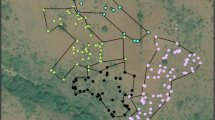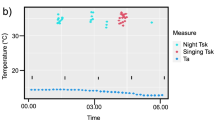Abstract
Neotropical katydids (Orthoptera: Tettigoniidae) are preyed on by gleaning bats, which are known to use male calling songs to locate them. At least one katydid species has been reported to stop singing in response to bat echolocation calls. To investigate the relationship between this behavioural defence and ecological and sensory factors, we surveyed calling song characteristics, song cessation in response to the echolocation calls of a sympatric gleaning bat (Trachops cirrhosus), and T-cell responses (an auditory interneuron sensitive to ultrasound) in five katydid species from Panamá. The two katydid species that stopped singing in response to bat calls (Balboa tibialis and Ischnomela gracilis, Pseudophyllinae) also had the highest T-cell spike number and rate in response to these stimuli. The third pseudophylline species (Docidocercus gigliotosi) did not reliably cease singing and had low T-cell spiking activity. Neoconocephalus affinis (Copiphorinae) produced continuous calling song, possibly preventing males from hearing the bat during singing, and did not show a behavioural response despite high T-cell activity in response to bat calls. Steirodon rufolineatum (Phaneropterinae) did not cease singing and differed in T-cell activity compared to the other species. T-cell function might not be conserved in katydids, and evidence for this idea is discussed.







Similar content being viewed by others
References
Bailey WJ (2003) Insect duets: underlying mechanisms and their evolution. Physiol Ent 28:157–174
Bailey WJ, Yeoh PB (1988) Female phonotaxis and frequency discrimination in the bushcricket Requena verticalis. Physiol Ent 13:363–372
Bailey WJ, Cunningham RJ, Lebel L (1990) Song power, spectral distribution and female phonotaxis in the bushcricket Requena verticalis (Tettigoniidae: Orthoptera): active female choice or passive attraction. Anim Behav 40:33–42
Belwood JJ (1988) The influence of bat predation on calling behavior in neotropical forest katydids (Insecta: Orthoptera: Tettigoniidae). PhD Thesis, University of Florida
Belwood J (1990) Anti-predator defences and ecology of neotropical forest katydids, especially the Pseudophyllinae. In: Bailey WJ, Rentz DCF (eds) The Tettigoniidae: biology, systematics, and evolution. Springer, New York
Belwood JJ, Morris GK (1987) Bat predation and its influence on calling behavior in neotropical katydids. Science 238:64–67
Bonato V, Facure KG, Uieda W (2004) Food habits of bats of subfamily Vampyrinae in Brazil. J Mammal 85:708–713
Brinkløv S, Kalko EKV, Surlykke A (2009) Intense echolocation calls from two “whispering” bats, Artibeus jamaicensis and Macrophyllum macrophyllum (Phyllostomidae). J Exp Biol 212:11–20
Brodie ED III (1989) Genetic correlations between morphology and antipredator behaviour in natural populations of the garter snake Thamnophis ordinoides. Nature 342:542–543
Dobler S, Stumpner A, Heller K-G (1994) Sex-specific spectral tuning for the partner’s song in the duetting bushcricket Ancistrura nigrovittata (Orthoptera: Phaneropteridae). J Comp Physiol A 175:303–310
Edmunds M (1974) Defence in animals: a survey of anti-predator defences. Longman, New York
Faure PA, Hoy RR (2000a) The sounds of silence: cessation of singing and song pausing are ultrasound-induced acoustic startle behaviours in the katydid Neoconocephalus ensiger (Orthoptera; Tettigoniidae). J Comp Physiol A 186:129–142
Faure PA, Hoy RR (2000b) Neuroethology of the katydid T-cell. I. Tuning and responses to pure tones. J Exp Biol 203:3225–3242
Fenton MB, Gaudet CL, Leonard ML (1983) Feeding behaviour of the bats Nycteris grandis and Nycteris thebaica (Nycteridae) in captivity. J Zool 200:347–354
Findley JS (1993) Bats: a community perspective. Cambridge University Press, Cambridge
Forrest TG, Lajoie DR, Cusick D (2006) Calling songs, duets, and auditory tuning in two cryptic katydids (Tettigoniidae: Phaneropterinae: Amblycorypha). Ann Entomol Soc Am 99:978–987
Forsman A, Appelqvist S (1998) Visual predators impose correlational selection on prey color pattern and behavior. Behav Ecol 9:409–413
Giannini NP, Kalko EKV (2004) Trophic structure in a large assemblage of phyllostomid bats in Panama. Oikos 105:209–220
Giannini NP, Kalko EKV (2005) The guild structure of animalivorous leaf-nosed bats of Barro Colorado Island, Panama, revisited. Acta Chiropterol 7:131–146
Griffin DR (1971) Importance of atmospheric attenuation for echolocation of bats (Chiroptera). Anim Behav 19:55–61
Gwynne DT (1991) Sexual competition among females: what causes courtship role reversal? Trends Ecol Evol 6:118–121
Gwynne DT (1995) Variation in bushcricket nuptial gifts may be due to common ancestry rather than ecology as taxonomy and diet are almost perfectly confounded. Behav Ecol 6:458
Gwynne DT (2001) Katydids and bush-crickets: reproductive behavior and evolution of the Tettigoniidae. Cornell University Press, Ithaca
Gwynne DT, Simmons LW (1990) Experimental reversal of courtship roles in an insect. Nature 346:172–174
Heller K-G, von Helversen D (1986) Acoustic communication in phaneropterid bushcrickets: species-specific delay of female stridulatory response and matching male sensory time window. Behav Ecol Sociobiol 18:189–198
Hill KG, Oldfield BP (1981) Auditory function in Tettigoniidae (Orthoptera: Ensifera). J Comp Physiol 142:169–180
Hosken DJ, Bailey WJ, O’Shea JE, Roberts JD (1994) Localisation of insect calls by the bat Nyctophilus geoffroyi (Chiroptera: Vespertilionidae): a laboratory study. Aus J Zool 42:177–184
Humphrey SR, Bonaccorso FJ, Zinn TL (1983) Guild structure of surface-gleaning bats in Panama. Ecology 64:284–294
Kalka M, Kalko EKV (2006) Gleaning bats as underestimated predators of herbivorous insects: dietary composition of Micronycteris microtis (Phyllostomidae) in Panamá. J Trop Ecol 22:1–10
Kalko EKV (2004) Neotropical leaf-nosed bats (Phyllostomidae): “whispering” bats or candidates for acoustic survey? In: Brigham M, Jones G, Kalko EKV (eds) Proceedings of a workshop on identification and acoustic monitoring of bats. Bat Conservation International, Austin
Kalko EKV, Krull D, Handley CO, Schnitzler HU (1999) Roosting and foraging behavior of two neotropical gleaning bats, Tonatia silvicola and Trachops cirrhosus (Phyllostomidae). Biotropica 31:344–353
Kavaliers M, Choleris E (2001) Antipredator responses and defensive behavior: ecological and ethological approaches for the neurosciences. Neurosci Biobehav Rev 25:577–586
Lang AB, Römer H (2008) Roost site selection and site fidelity in the neotropical katydid Docidocercus gigliotosi (Tettigoniidae). Biotropica 40:183–189
Latimer W, Sippel M (1987) Acoustic cues for female choice and male competition in Tettigonia cantans. Anim Behav 35:887–900
Lawrence BD, Simmons JA (1982) Measurements of atmospheric attenuation at ultrasonic frequencies and the significance for echolocation by bats. J Acoust Soc Am 71:585–590
Libersat F, Hoy RR (1991) Ultrasonic startle behavior in bushcrickets (Orthoptera; Tettigoniidae). J Comp Physiol A 169:507–514
McKay JM (1969) The auditory system of Homorocoryphus (Tettigonioidea, Orthoptera). J Exp Biol 51:787–802
Nabatiyan A, Poulet JFA, de Polavieja GG, Hedwig B (2003) Temporal pattern recognition based on instantaneous spike rate coding in a simple auditory system. J Neurophysiol 90:2484–2493
Naskrecki P (2000) The phylogeny of katydids (Insecta: Orthoptera: Tettigoniidae) and the evolution of their acoustic behavior. PhD Thesis, University of Connecticut
Nickle DA (1992) Katydids of Panama (Orthoptera: Tettigoniidae). In: Quintero D, Aiello A (eds) Insects of Panama and Mesoamerica: selected studies. Oxford University Press, Oxford
Page RA, Ryan MJ (2008) The effect of signal complexity on localization performance in bats that localize frog calls. Anim Behav 76:761–769
Poulet JFA, Hedwig B (2002) A corollary discharge maintains auditory sensitivity during sound production. Nature 418:872–876
Poulet JFA, Hedwig B (2003) Corollary discharge inhibition of ascending auditory neurons in the stridulating cricket. J Neurosci 23:4717–4725
Rheinlaender J, Römer H (1986) Insect hearing in the field. I. The use of identified nerve cells as “biological microphones”. J Comp Physiol A 158:647–651
Schul J (1997) Neuronal basis of phonotactic behaviour in Tettigonia viridissima: processing of behaviourally relevant signals by auditory afferents and thoracic interneurons. J Comp Physiol A 180:573–583
Stapells DR, Picton TW, Smith AD (1982) Normal hearing thresholds for clicks. J Acoust Soc Am 72:74–79
Suga N (1966) Ultrasonic production and its reception in some neotropical Tettigoniidae. J Insect Physiol 12:1039–1050
Suga N, Katsuki Y (1961) Central mechanism of hearing in insects. J Exp Biol 38:545–558
ter Hofstede HM, Fullard JH (2008) The neuroethology of song cessation in response to gleaning bat calls in two species of katydids, Neoconocephalus ensiger and Amblycorypha oblongifolia. J Exp Biol 211:2431–2441
ter Hofstede HM, Ratcliffe JM, Fullard JH (2008) The effectiveness of katydid (Neoconocephalus ensiger) song cessation as antipredator defence against the gleaning bat Myotis septentrionalis. Behav Ecol Sociobiol 63:217–226
Trivers RL (1972) Parental investment and sexual selection. In: Campbell B (ed) Sexual selection and the descent of man. Aldine Publishing Company, Chicago
Tuckerman JF, Gwynne DT, Morris GK (1992) Reliable acoustic cues for female mate preference in a katydid (Scudderia curvicauda, Orthoptera: Tettigoniidae). Behav Ecol 4:106–113
Tuttle MD, Ryan MJ (1981) Bat predation and the evolution of frog vocalizations in the neotropics. Science 214:677–678
Weinbeer M, Kalko EKV (2007) Ecological niche and phylogenetic constraint: the highly complex echolocation behavior of the long-legged bat, Macrophyllum macrophyllum. Behav Ecol Sociobiol 61:1337–1348
Wilson DE (1973) Bat faunas: a trophic comparison. Syst Zool 22:14–29
Acknowledgments
We thank the staff at the Smithsonian Tropical Research Institute facilities at Barro Colorado Island for their logistical support and assistance, especially Oris Acevedo and Belkys Jiménez. Thanks also to Rachel Page for joint work on the foraging behaviour of Trachops cirrhosus, from which we obtained the echolocation recordings, Peter Wall for the custom MATLAB application, and Negin Amin for data analysis. Funding for this study was provided by the Natural Sciences and Engineering Research Council of Canada (discovery grant to J.H.F and postgraduate scholarship to H.M.tH.) and the Smithsonian Tropical Research Institute (short term fellowship to H.M.tH.). Holger Goerlitz and Brock Fenton provided helpful comments on the manuscript. Experiments described here comply with the “Principles of animal care” publication No. 86-23, revised 1985, of the National Institute of Health, and also with the current laws of the country in which the experiments were performed.
Author information
Authors and Affiliations
Corresponding author
Rights and permissions
About this article
Cite this article
ter Hofstede, H.M., Kalko, E.K.V. & Fullard, J.H. Auditory-based defence against gleaning bats in neotropical katydids (Orthoptera: Tettigoniidae). J Comp Physiol A 196, 349–358 (2010). https://doi.org/10.1007/s00359-010-0518-4
Received:
Revised:
Accepted:
Published:
Issue Date:
DOI: https://doi.org/10.1007/s00359-010-0518-4




